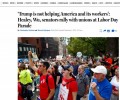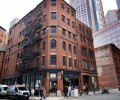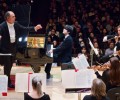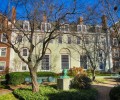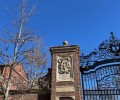| Death in Venice |
| 보스톤코리아 2006-08-14, 00:42:38 |
|
이 에세이는 Middlesex School 12학년에 재학중인 이민형 학생이 쓴 글이다.
After much exploration of the complex nature of love, beauty, art, and artists, Death in Venice ends with a rather beautiful description of the vast distance and the calm, broad ocean stretching in front of Aschenbach, causing one to think that he dies appreciating and striving after something beautiful and dignified. However, the end of the novel suggests that even "simple, pure innocence" leads one to "intoxication and desire" (137) implies that artists have an inherent penchant for the abyss, a proclivity which they suppress. Although he seems to pursue beauty, the artist is not really led to true beauty, and his mind and body simply become diseased. At his very last moment of life, Aschenbach sets out to the "infinitude" (141) and "promising immensity" (142), believing that he is approaching the true beauty before him, Tadzio; however, this beauty is not true beauty but a trick that leads to the endless, immense abyss. Aschenbach's "hopelessness and helplessness" (138) in the face of indulgence and lust are because of his "natural, inborn, incorrigible" (137) propensity to desire "the reprehensible" (135). He has received the "darker, more fiery impulses" (12) and the "impetuous, sensual blood" (12) of his mother, who is the daughter of a Bohemian bandmaster, a symbol of excess and passion, as opposed to the "rigid, cold" (8) nature of his father. Aschenbach is "not born to" his "constant industry" (13), and, therefore, if left unrestrained, he is "prone to blithe approximations and half-perfections" (9), rather than the masterpieces he has produced. Since he is inherently wanton and attracted to adventures, he has always had to suppress adolescent desires and strive to "outgrow the libertine chrysalis stage" (21) in order to receive the "dignity of the intellect" (21). To Aschenbach, passion has been an "obstacle" along with "affliction, poverty...vice" (16), and thus he has always "bridled and cooled" (9) his feelings and allowed no leisure, feelings, or the "carefree idleness of youth" (13). Aschenbach's wanderlust and love for Tadzio are not "sudden and belated impulses" (7) or unexpected, bizarre changes to his originally venerable and normal self; such "youthful longing[s]" (124) are his real nature, which he has been concealing and suppressing, and now they are simply springing back up, as if rebelling. At the end of the novel, Jasiu, the friend of Tadzio who has all along been described as "inferior" and "vassal" (58), triumphantly beats Tadzio up. The "dark, black-haired" boy (140) is parallel to the dark desires of Aschenbach which have been restrained all along. As Aschenbach thinks that "this underling's deferential sentiments... [now seek] revenge for his long enslavement" (139), one recalls Aschenbach's reference to his sudden impulses as "his indentured sensibility...now taking its revenge" (9) against that which has deprived him of "all pleasure, all delight" (9). The children get "unruly and...out of hand" (139), because they are now "unsupervised" (139); like- wise, the previously subdued nature of the artist becomes wild and irrepressible, once he neglects control and lets his disciplined life loose. Tadzio's resistance against the burden of the revolting attacker gradually decreases and soon "recurs only as twitches" (140); correspondingly, Aschenbach's initial scruples arising from his "distaste for [work]" (9) and his "urge to flee his work" (8) disappear, and eventually his chaotic state of mind is "of no concern to him" (129). In the end, he ceases to resist his childish craving, which is essentially in his nature, and blatantly indulges in lustful pleasure. Despite the seeming change in Aschenbach's nature throughout the novel, there is no fundamental change in him; he is an artist and his innate disposition is inescapable. Aschenbach's digression from his "disciplined, austere life" (12) to the ultimate chaos and the abyss is due not only to the artist's intrinsic, "inner dissolution" (17) but also to the nature of beauty. What one believes to be beauty is not true beauty, for beauty cannot be sensed by the mere perception of human senses; thus, by taking the seeming path to beauty and dignity, one is instead led astray to a "path of sin and delusion" (136). Aschenbach is allured to what seems to be true beauty, yet the beauty, which his mere eyes perceive and evaluate, is not true beauty but, in fact, a spell and trickery. At the end of the novel, he "suffers from dizzy spells" that have invaded his mind while he has been pursuing Tadzio, whom Aschenbach believes to be true beauty, which is essentially a pathway to deep indulgence and chaos. Eros has joined Aschenbach in his pursuit of beauty, Tadzio, and, under the disguise of this path of beauty, Aschenbach is indeed led to lust and profligacy. Aschenbach is also inevitably led to the abyss, because beauty is the path to love, and love is a disease; accordingly, by pursuing beauty, he falls in love and becomes diseased and disordered. The cholera that engulfs the city of Venice is equivalent to the love that infects and eventually destroys Aschenbach's mind and body. The epidemic spreads in the city furtively and under concealment, just as his love for Tadzio spreads in his mind subtly and under the guise as a pursuit of true beauty. As much as the city people try to prevent, ignore, and hide the infection, Aschenbach, all through his life, tries to resist passion and desires in his nature and lies to himself that he is a disciplined, dignified man who "renounces all sympathy for the abyss" (135). Yet the city cannot fight off the disease, and Aschenbach cannot fight off the love and lust that overwhelm him uncontrollably. At the end of the novel, he feels "indisposed" (138), because he has been deeply intoxicated with his lust for Tadzio. The "culture of a life time" (126) is devastated and obliterated, both in Venice and Aschenbach. The novel subtly yet unmistakably suggests that all leads to the abyss. Above all, there is no doubt that knowledge, which Aschenbach calls "disintegrative erudition" (20), leads to the abyss; the Garden of Eden belongs only to those who are not knowledgeable, and as soon as Adam and Eve taste the fruit of the Tree of Knowledge they are condemned to the abyss. Beauty is more complex. Only true beauty leads to "wisdom," divinity, and "the true dignity of man" (136), yet human senses are confined merely to the traces and shadows of beauty, which are, in essence, never the true beauty. Even simplicity and innocence that seem beautiful lead "a noble man to horrifying crimes of passion" (137) which he "reprehends as infamous" (137) and, ultimately, to the abyss. All the men whom Aschenbach encounters-the guy at the train station, the old fop on the ship, the gondolier, and the mime-are gruesome outsiders, artists to some extent, who are characteristic of the abyss. The exotic man at the station stands above two apocalyptic beasts, reminding one of the abyss and hell. The old fop tries to follow the path of beauty by beautifying himself, an effort which only results in his looking "ghastly" (35) and abyss-belonging, like a "spruced-up fossil" (33). The mime demonstrates perfectly that artists are tricksters and belong to the abyss. This "brash, dangerous, and entertaining" (112) performer manipulates the spectators, covers his vulgarity beneath temporary courtesies and art, and impudently lies to Aschenbach that there is absolutely no disease. His "artificial laughter" (115) is so "contagious" (116) that the audience is tricked into laughing with him without knowing why. Also, simply the fact that the mime is down in the garden while the audience is up on the terrace evokes an image that he is in the abyss. Art is a "hazardous enterprise that should be outlawed" (137). Aschenbach, an artist himself, is connected to all these "artists"; although he is repulsed and taken aback by these people, he is oddly intrigued by them and looks at them intently-perhaps because they have in common the artist's longing for beauty which leads them to the abyss. Eventually, Aschenbach comes to resemble these men, who all share similar attires and physical features, including a "naked-looking Adam's apple" (112), which is a sensual image that also relates to the fruit of the Tree of Knowledge. These men who are "out of the ordinary" (3) and outside the restraining social convention are doomed to end up in the abyss. The last depiction of the beach of Venice is analogous to Aschenbach's final state of mind; the mind of the renowned author, as well as the desolate beach, has once been "so colorful and animated" (139) but is now "deserted" (139) and "no longer kept clean" (139). The grisly image of the abandoned camera with the "black cloth draped over it" (139) foreshadows Aschenbach's death scene, which is empty and wholly lacks dignity. His head is "sunk down on his chest" (141), his last expression is "slack... [and] of deep slumber" (141), and his body is "slumped sideways" (142) in a chair. Aschenbach's previous image as a "tight fist" (13), for which he has been greatly respected, is nowhere to be seen in his last moment of life; he has degenerated into a hand "dangling loosely from the arm of a chair," because of his deep-rooted penchant for self-indulgence and indolence. Such an unsightly death verifies that indulging oneself in one's lust and passion-Tadzio in Aschenbach's case-until one's last breath does not bring one to true beauty, but to the deep, inescapable abyss. |
|
 |
 의견목록 [의견수 : 0]
의견목록 [의견수 : 0]
|
 |
| 등록된 의견이 없습니다. | |
|
|
 프리미엄 광고
프리미엄 광고

161 Harvard Avenue, Suite 4D, Allston, MA 02134
Tel. 617-254-4654 | Fax. 617-254-4210 | Email. [email protected]
Copyright(C) 2006-2018 by BostonKorea.com All Rights Reserved.
Designed and Managed by Loopivot.com












